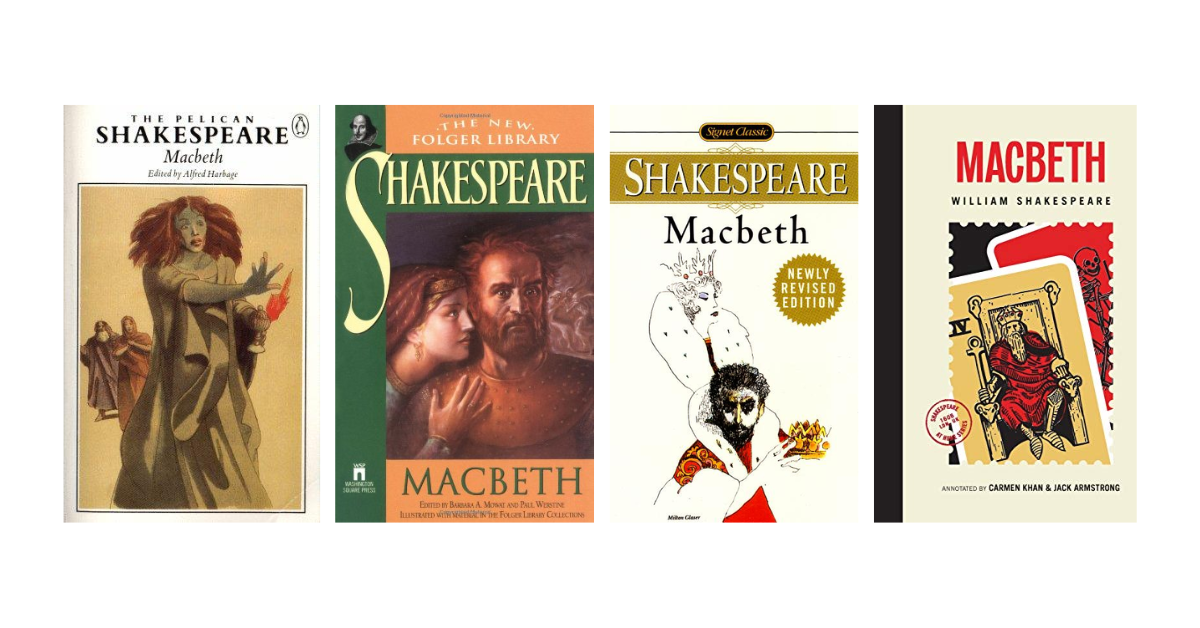William Shakespeare’s Macbeth remains one of the great classics of English literature and is a popular book choice for many who enjoy reading literary works. Consequently, countless book covers graced the book over the years, from iconic designs that have gone down in history to more modern covers featuring artwork, photography, or unique typographic treatments. Each of these Macbeth book covers represents a different take on how to visually portray the themes, characters, and atmosphere of this book by William Shakespeare.
Table of Contents
The Macbeth Book Covers
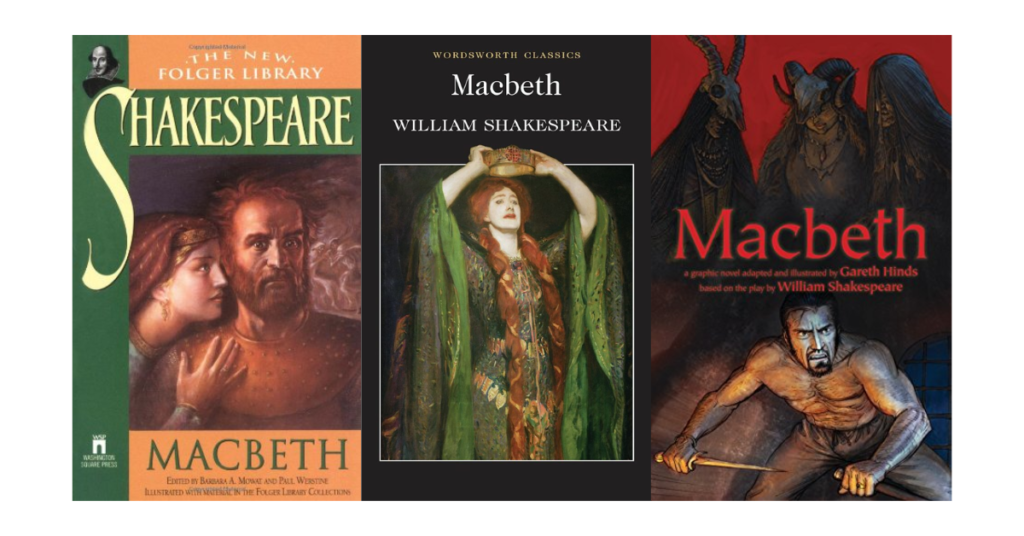
Macbeth, William Shakespeare’s classic tale of ambition and power, has inspired multiple cover designs as decades come. Each book cover tells its tale, providing clues into its narrative and indicating historical shifts in understandings of Macbeth from 17th-century trends to modern interpretations, all offering a captivating view into this timeless tragedy.
Our compilation of Macbeth book covers offers a great starting point for those looking to explore the beauty of this literary classic! Since Goodreads has over 8,000 editions, we’ve curated some of the best ones to form this list, consisting of classic ones and those that incorporate modern interpretations of the book. Rest assured, this book cover selection presents the artistic changes the covers undergo through the years, which you will enjoy.
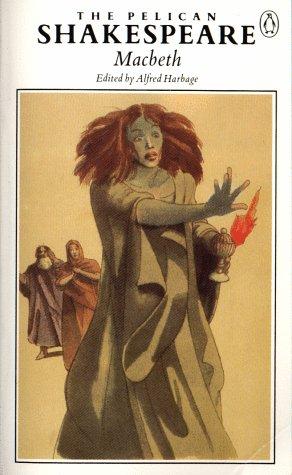
The mass market paperback edition released by Penguin Classics in 1956 has a book cover that features an expressive and stark piece of art. An illustration occupies most of this book cover, showing a stunned lady holding an orb and staring at her right hand. Two figures are behind her, both wearing surprised look on their faces. The artwork resembles the trending art style during the 1950s, featuring cartoony drawing styles. A black line borders this iconic image, separating it from the text above. This striking design captivates readers with the iconic combination of minimalism and impactful imagery.

The book cover of Macbeth, released by Washington Square Press as part of The New Folger Library in 1992, is mesmerizing and haunting. The stunning orange-green palette is vital, making the cover artwork cohesive. For the most part, this cover illustrates a fierce warrior with a serious look, almost as if he is preparing for a fight or pondering the consequences of a decision he’s about to make. A woman stands beside him, looking at him with mischievous eyes as if encouraging this man to go on with his pursuits. Most of the text is in a serif font with “Shakespeare” as the largest on the page, echoing the just-as-bold imagery. Overall, this book cover is another captivating image befitting a powerful and dramatic Shakespearean tragedy.
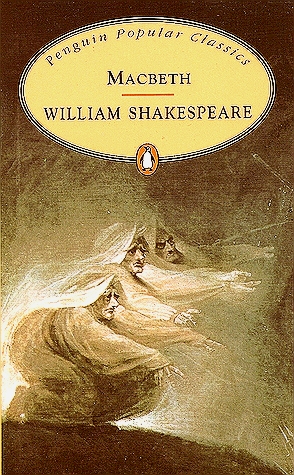
This book cover which Penguin Books published for Macbeth in 1994, shows a very eerie and mysterious design that reflects the art style used for horror, thriller, or suspense stories during its time. It features three mysterious figures, possibly the three witches, which played a significant part in the story. The faces of the witches are in detail, each with pointed noses, eyes so deep, and frowning in different ways. The witches have long, wild hair that flows out extravagantly, which, from another point of view, may look like hoods connected to their robe-like gowns. They all have their arms stretched as if reaching out to someone. Black, gray, and yellow shades create a dark and chilling atmosphere, especially since these colors fill the space in this artwork. An unparalleled air of mystery and menace radiates from the cover, perfectly capturing the horror and dread felt throughout the story.

Here’s another book cover that’s evocative and captivating, heavily relying on symbolic elements. Set against a sun-lit background is a golden, masquerade-style mask with wide eyes and a curved and opened mouth. Apart from showing a facial expression that suggests the character’s surprise or weariness, the mask also contains symbols related to Macbeth. These symbols include the three faces (possibly to symbolize the three witches), the daggers pointed upward (hints at the violence in this story), and swirling ribbons at both sides that may indicate bloodshed. The placement of the mask in the middle highlights the lesson of the tragedy very briefly – that no one, no matter how powerful, is exempt from the consequences of their decisions.
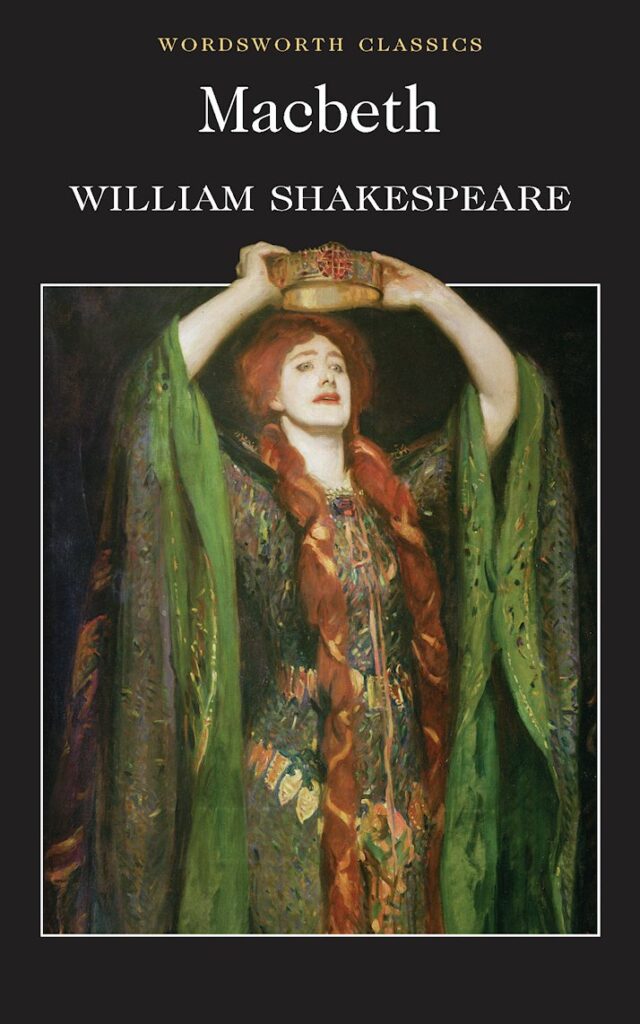
This Macbeth book cover, published by Wordsworth Editions Ltd in 1997, features a bordered image of the infamous Lady Macbeth with her hands clutching a golden crown to her head. She has piercing blue eyes gazing straight out of the page, and downturned red lips, set tight with purpose, presenting a vivid contrast to her cool ivory skin. Her facial expression shows a simultaneous sense of awe and fear, suggesting her tenacious determination to gain power by taking the throne. Apart from the image of Lady Macbeth, this book cover has the title and author’s name on top in a white serif font, which stands out in contrast to the rest of the book cover. The minimal text, darkness, and the solitary woman at its center make this stark image of one woman’s burden of ambition and her unwavering commitment to power the focus, igniting readers’ interest in this lady’s part in the story of Macbeth.
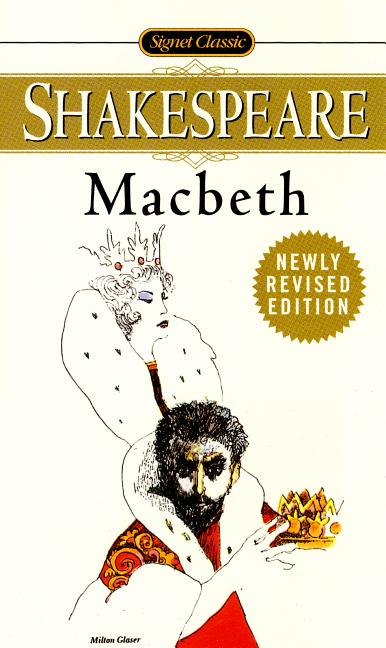
Editions released by Signet/Signet Classics are often fan favorites, not only for their text but also for their cover design. For example, the edition released in 1998 features a stunning example of classical artistry combined with modern appeal. Regal gold, black, and red hues dominate this cover which centers on the two figures dressed like royalty. Lady Macbeth’s position above Macbeth indicates Lady Macbeth’s influence on her husband and how she manipulates Macbeth into doing heinous acts to gain power and seize the throne. This book cover delivers a clear representation of themes like power-hunger, as well as the central role of Macbeth’s ambition, expertly capturing the dynamics between the characters, the drama, and the tragedy of the story with a modern and minimalistic approach, which back then was ahead of its time.

This mass market paperback edition of Macbeth from The Folger Shakespeare Library exudes an enchanting allure, as the rich shades of purple dominate the cover. This color conveys royalty and grandeur—reflecting Macbeth’s ambition and power-hunger—and the supernatural elements present in the play. Delicate wisps of mist curl and dance across, which also looks like a woodland scenery captured on film. This purple Macbeth book cover’s overall effect is intriguing, beckoning readers to explore the dark depths of ambition, guilt, and the consequences of Shakespeare’s tragic masterpiece.
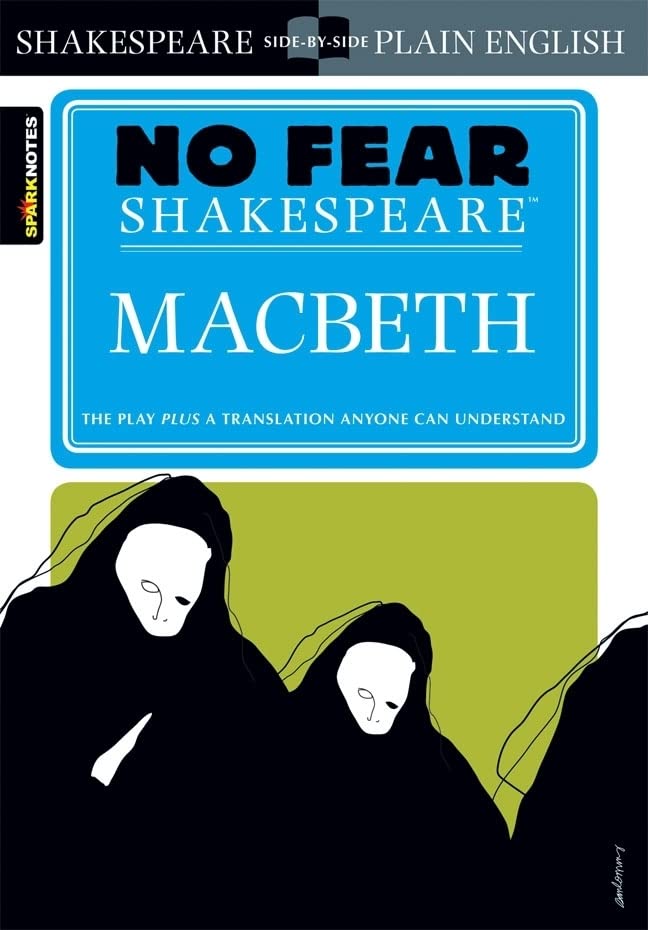
The book cover of Macbeth released by SparkNotes is a vivid, haunting example of their No Fear Shakespeare study guides. Although it’s less detailed than other cover artworks in this list, it managed to capture the eeriness contained in Shakespeare’s play. It features three mysterious figures (one with only their shoulder visible), which may depict the three witches in the story, considering they all seem to be wearing dark cloaks. Apart from this, the rest of the cover only shows the text, including the book and series’ title, over a blue-bordered textbox. Simple and keen, that’s what this book cover embodied!

The new edition released by Cambridge University Press in 2005 for Macbeth as part of their best-selling Cambridge School Shakespeare series features a striking book cover. The cover presents a deep black background that slowly turns dark blue towards the right side, overlaid with a photograph of a man staring at his blood-filled hands. This grim setting stands out against the dark colors and adds to the book’s eerie atmosphere. The title is on the right side, presented vertically in a bold white font, offering excellent contrast to the cover’s darkness. These features excellently capture the themes of dread and dreadfulness found throughout Shakespeare’s masterpiece. In addition to hinting at the story’s contents, this cover perfectly encapsulates the tragedy’s macabre undertones, setting the stage for a genuinely epic reading experience.
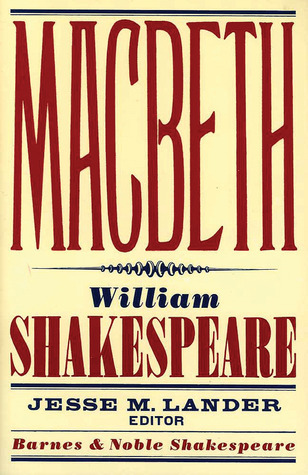
Barnes & Noble Shakespeare’s edition of Macbeth features a contemporary and minimalist book cover heavily focused on typography. The background is yellowish cream, making the text stand out with its red and blue/black color. The title covers almost half the page with a modern serif font making it the focus of this book cover. Beneath the title, there’s a little ribbon that separates the title from the author’s name. The author’s name consists of two fonts, with the editor’s name in a fixed-width typewriter-like font. While the use of too much-varied fonts is shunned by most designers today, thanks to its sophisticated typography, this rendition of Shakespeare’s classic tragedy exudes a timeless feel.

The Macbeth book cover published by Oxford University Press in 2009 is an opulent yet simple illustrative design. A golden crown sits atop the white background, creating an overall feeling of brilliance and simplicity. Its reflection or shadow makes another version of the same crown but in red color, metaphorically representing the duplicity and inner turmoil of the play’s characters. The crown, the central symbol for this book cover, appears drawing-like, almost like a colored sketch. Only minimal text is used for this cover, with the title on top in a pastel yellow serif font and against a dark pink background and the author’s name at the bottom in a pink sans serif font and against a pastel yellow background. These elements combine to create a sleek yet powerful cover, mirroring the play’s story of ambition, greed, and hidden truths.

This Macbeth book cover by Crossway, released in 2013, boasts a neat book cover with a solid green foreground. Right in the background lies a magnificent crown with a dagger pierced in the middle. All text is in the middle portion of the cover, with the edition on top, the title in the center, and the editor at the bottom. This edition is another simplistic cover that proves the proper use of elements makes a book cover stand out.

The hardcover edition of Macbeth, released by Candlewick in 2015, has an eerie and detailed cover that captures the spirit of Shakespeare’s play. It illustrates the main character holding a dagger with an expression of anguish etched on his features and the three witches staring down at him with sinister appearances. The shades of red and black that make up the illustration and text make this cover even more spooky, making this intense imagery accurately portray the ambiguity of Macbeth’s character and story.
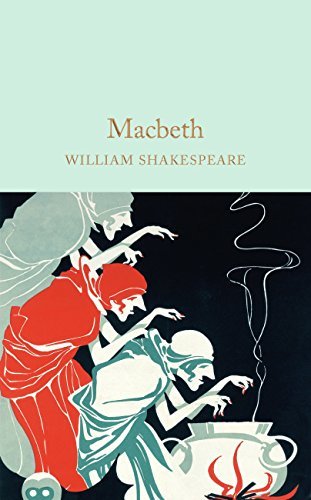
The book cover of Macbeth, released as part of the Macmillan Collector’s Library edition, is a visually arresting design. Against a deep navy background, three witches painted in shades of gray, red/orange, and white stand in a similar pose. They have the same pointed nose and chin, soullessly staring at a cauldron as if boiling a nasty concoction. Meanwhile, on the other part of this cover lies the title and author’s name in a gold serif font against a light blue-green background. This cover is an imaginative and subtly somber homage to one of Shakespeare’s most iconic plays.
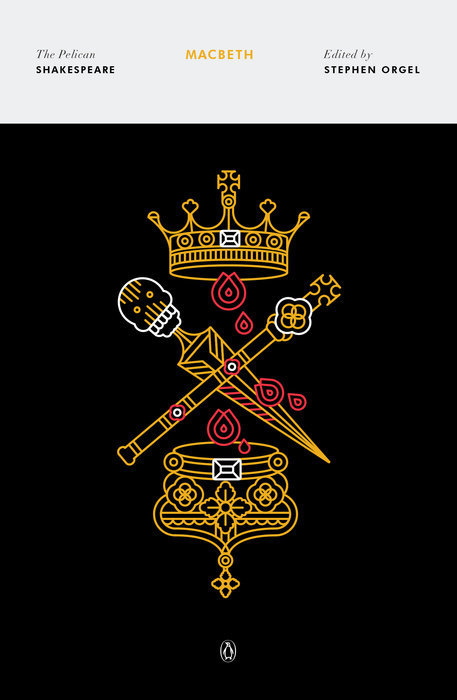
Penguin Books released a stunning new design for their acclaimed Pelican Shakespeare series in 2016, which includes the cover art Manuja Waldia created for Macbeth. This dazzling book cover and the rest of what Waldia designed for the series gained her a Gold Medal from the Society of Illustrators. It’s not surprising, especially once you see her designs! For Macbeth, Waldia used symbols over a stark black backdrop: a clever way to make her design stand out. The signs include a tiara, a nobleman’s crown, a dagger, and a scepter. The tiara pours blood onto the crown, crossing a scepter and dagger on its way. This image symbolizes Lady Macbeth’s deadly ambition and bloodlust, which influenced her husband, Macbeth, leading to violence and a bloodbath, all so they could attain power. This cover is truly an iconic representation of the timeless story of Macbeth and a prime example of symbolism put to great use in book covers.
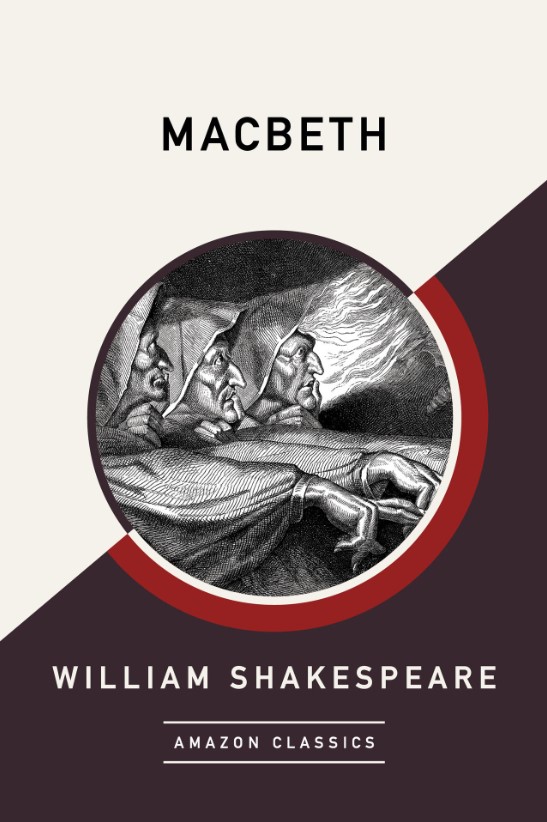
The book cover of Amazon Classics’ 2017 release of Macbeth presents the mysterious and eerie atmosphere contained in the story through its book cover. At the center lies a pencil-like drawing of three witches, eyes staring and hands pointing in one direction and surrounding the diagonal half of the circle where the illustration is a red border. Diagonally cut in half, this cover has two background colors: dirty white and dark violet. On the other hand, the typography is sans serif, which completes the minimalistic look of this cover.

The book cover of Macbeth, released by the Armin Lear Press in 2020, features two cards illustrated together in one drawing with a stamp-like border. The yellow card displays a bold image of a king sitting on his throne. Meanwhile, the red card behind shows a skeleton, possibly signifying death. The cover’s cream-colored background makes the illustration and sans-serif text more noticeable. While its design might be simple, the elements on this cover say enough to make potential readers interested in browsing the book for more.
An Insight About William Shakespeare’s Macbeth
William Shakespeare’s Macbeth is one of the greatest works in English literature. Recognized for its portrayal of ambition, power and moral ambiguity – as well as offering many insights into human behavior – this timeless tale provides much insight into human nature and is one of its hallmark works of literature.
Macbeth tells the tale of Macbeth, a Scottish nobleman lured by three witches into believing his destiny lies in greatness. With loving yet often misguided encouragement from his wife, Lady Macbeth, he embarks on a bloody action to strengthen his power. Macbeth undertakes an act that involves murdering King Duncan of Scotland to take his throne—only for him to feel guilt and paranoia and experience the consequences of his deeds. Spoiler alert: the story ends tragically as Macbeth’s actions result in him being killed in battle by Macduff, ensuring that the rightful king ascends to the throne!
William Shakespeare’s Macbeth remains one of the world’s most beloved plays, still performed worldwide and adapted for book, radio, TV, and film adaptations. Considered one of his greatest tragedies, Shakespeare’s Macbeth continues influencing and inspiring artists and writers, making a statement 400 years after its first publication.
FAQs about the Macbeth Book Covers
Q: Why are there different book covers for Macbeth?
A: Each edition and publisher often create their distinctive book cover to attract readers and distinguish their version of the play/book from others’ versions based on artistic interpretation, design trends, target audience, or target reading level.
Q: Are there any specific symbols or images commonly found on Macbeth book covers?
A: Macbeth’s book covers often feature images or symbols related to key themes in the play, such as ambition, power, guilt, and the supernatural. You might see crowns, daggers, bloodstains, or images depicting witches among mist or dark landscapes – among many other visual references that bring these themes alive.
Q: How do Macbeth’s book covers differ?
A: Macbeth’s book covers vary in artistic style, color schemes, imagery, and typography. Some book covers may feature abstract or minimalist designs while others depict specific scenes or characters from the play; overall tone and mood may also change from dark and foreboding to vibrant and symbolic.
Q: Do book covers of Macbeth differ across countries or editions?
A: Yes, book covers for Macbeth may differ significantly across different countries, editions, publishers, cultural influences, and target audience preferences can lead to diverse interpretations and designs for this classic text.
Q: Where can I find different Macbeth book covers?
A: To explore various Macbeth book covers, look as far as your local bookstores, libraries, or online retailers such as Amazon. Websites like Goodreads also often showcase multiple editions with their covers!
Conclusion
William Shakespeare’s Macbeth remains a timeless classic. Contributing to its long-running and established success in literature is how publishers designed its book covers. Through the years, the book covers for this epic play reflect various eras, continuously making it attractive for people of different generations. The clever use of typography, art styles for the illustrations, symbolism, and fantastic combinations of color palettes provides valuable insights into Macbeth’s narrative. Studying these elements can inspire anyone who wants to learn how to make stunning cover designs.
Through studying our list of covers of Macbeth, authors can gain new inspiration for crafting engaging stories; illustrators can explore new visual styles; publishers gain invaluable insights into promoting books in modern markets; while readers gain a unique glimpse of this powerful tale; it allows them to imagine all its tragedies, horrors, and drama with ease. These interpretations of Macbeth through art will continue enduringly influence generations yet unborn.
Are you in search of additional book cover design inspiration? Check out our Book Cover Ideas Blog here.

